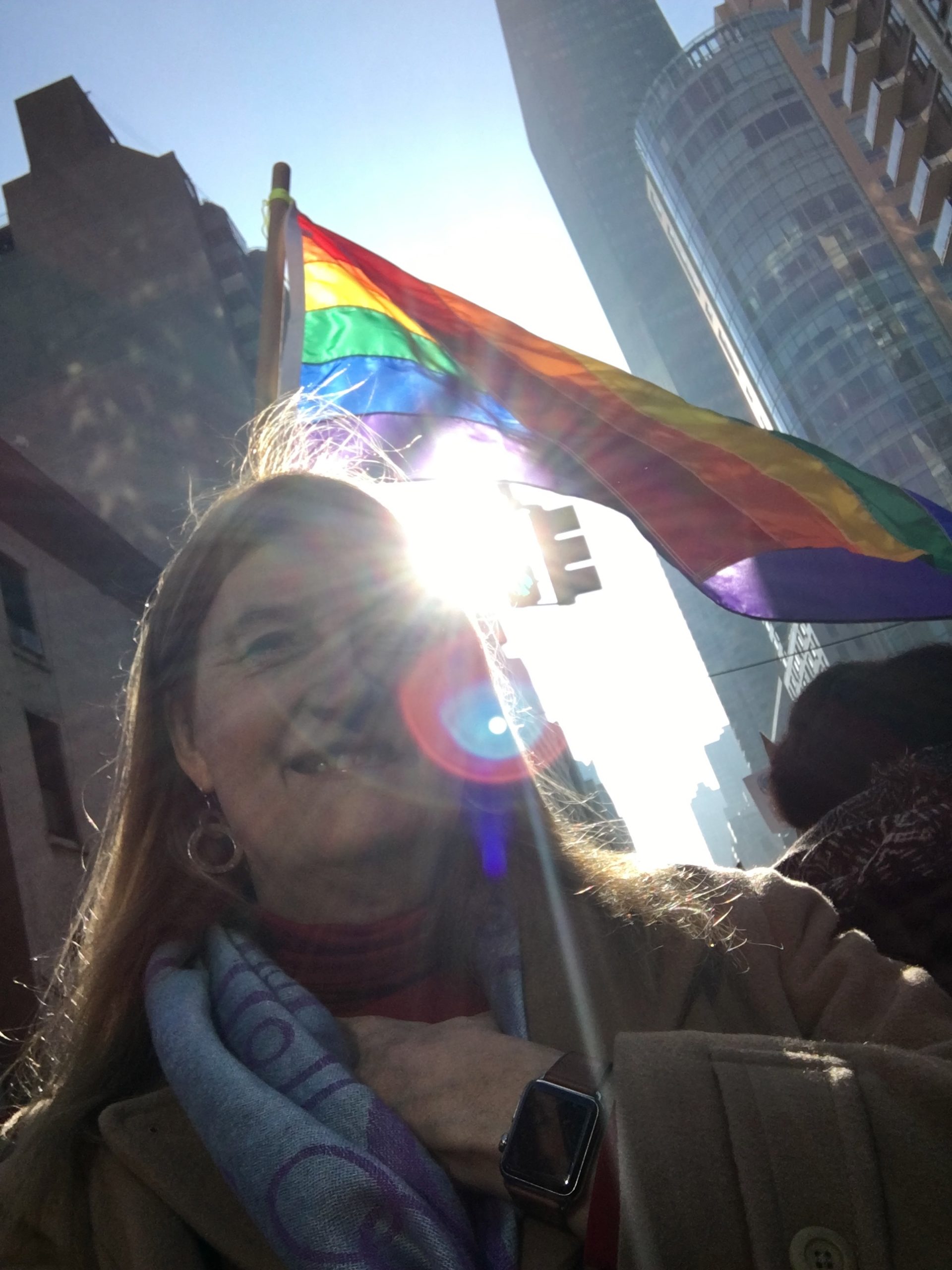“Love will prevail.”— Hildegarde Boylan, (Jenny’s mother.)
Jennifer Finney Boylan is the author of many books which address LGBTQ identity, including the memoirs SHE’S NOT THERE; I’M LOOKING THROUGH YOU; and GOOD BOY. For many year she was co-chair of the board of directors of GLAAD, the media advocacy group for LGBT people worldwide. GLAAD provides hundreds of resources for gay, trans, lesbian, bi, and queer or questioning people, and those that love us. Since 2017 she has been a Trustee of PEN America, the nonprofit advocating for freedom of expression worldwide.
I’m transgender, or someone I love is, and I’m looking for resources. What do you recommend?
The best all around resource on the very diverse world of trans people is Trans Bodies/Trans Selves, published by Oxford University Press, and edited by Laura Erickson-Schroth. This 600+ page book is a compendium of resources and information and stories about the full range of experiences and needs of our community. I can’t recommend it highly enough. If you’re looking for it, it’s in here.
You’ve been “out” as trans for over fifteen years now. How have things changed?
There are many more ways of being trans in the public eye now, from being genderqueer or gender non-conforming to a cross-dresser to drag kings and queens to transsexual men and women. It is complex for our community—not to mention those who wish to be our allies— that so many different ways of embodying gender are often grouped under a single umbrella— “trans” or “transgender.”
It means that people who may disagree on what the leading issues are, or what the discourse ought to be—whether being trans is about medicine, or culture or performativity, or fantasy, or something else entirely—can find themselves grouped together. It can make for tight quarters.
I like to say, “If you’ve met one transgender person, you’ve met— one transgender person.” There are a lot of ways of being us.
It’s important that, as people emerge into their identity that they have the freedom to express themselves in whatever way they feel without anyone else having an opinion about it. There is no wrong way to be trans. The diversity of our community is its strength. We are all cool.
How did you keep your marriage together? Do you consider yourself gay or straight?
My sense of desire has remained constant, which is to say I liked women before and I like women now. And while I can say that I “see” men in a way that I didn’t in the first half of my life, I’m still primarily attracted to one person, namely my wife Deedie, also known as Grace in my books. So in that sense I was straight “before” and I’m lesbian oriented now.
That said, I can tell you that I’ve seen virtually every variation among the trans people that I know. Some people’s sexual orientation does change— others “revert” to their original object of desire; still others become kind of asexual. I think it’s important to differentiate between sexual orientation (gay or straight) and gender identity (who you feel yourself to be). Or, as I like to say, It’s not about who you want to go to bed with, it’s about who you want to go to be as. Still, sex and gender are not completely unrelated, and the ways they overlap, or not, is part of the great mystery of our lives. I think that this too is something we should celebrate.
My wife and I stayed together, but it took us a long time to figure out what this means. I can tell you we are not as unusual as people think; the current research shows that about a third of marriages stay together, and the longer the couple has been married, the more likely the couple will endure.
What do you recommend for people trying to address these issues? What advice do you give?
I am generally not in the advice business. Everyone has to figure out this territory for themselves, and we should all be very careful about telling other people to follow in our footsteps. Surely whatever was true for me was largely the result of my own unique life, the place where I have lived, and the people around me. As the old spiritual has it, You’ve got to walk that lonesome valley.
That said, I would summarize my Advice with the acronym T.R.U.E.
T stands for Therapy. (or Talk). Find a counsellor, preferably one trained in gender issues, and get this secret off of your chest.
R stands for Read. There are a lot of good books about trans experience. In addition to my own work, I love the memoirs of Joy Ladin, who I think is one of the most articulate writers about trans issues—and faith—that I know. Helen Boyd’s book, My Husband Betty, is a great resource for spouses. But there are many, many good books, by Janet Mock and Chaz Bono and Susan Stryker and Julie Serrano, and Jameson Green, and Leslie Feinberg.
U stands for You be You, whoever that may be, and on your own terms.
E stands for Euphoria. Seek your joy, wherever you can. This does NOT mean that you should do exactly as you please without any plan for the future, and sometimes “seeking euphoria” means to make a long-range strategy for coming out and being in the world. But whether your joy is about a single afternoon or the rest of your life, it should be your goal. And I wish you love upon your journey.
Will you read my book, or help me get my book published, or provide a blurb for my writing?
I wish I could help everyone who sends me their work, but I’m almost always overwhelmed with my own work, and after that, with the needs of my family, and my students. In general, your best bet is to find an agent to represent you, and to work with him or her. There are lots of good resources on the web for finding an agent.
What’s your favorite book of your own?
The three gender memoirs— She’s Not There; I’m Looking Through You; and Stuck in the Middle With You—are dear to my heart. Of these three, the middle child, I’m Looking Through You, is the one that was the hardest to write. It’s about growing up in an allegedly haunted house, and uses the metaphor of “haunting” to talk about what it means to occupy a body, and also to investigate the way we can be haunted by ourselves, by the ghosts of the people we have been, and how these sometimes stand in the way of us becoming our true selves. Parts of this book are very dark. I feel like the joy I find at the end of the story was very hard-won.
Who are your favorite writers?
I think our two best fiction writers are George Saunders and Jennifer Egan. Saunders’ collection of stories, “Tenth of December” is pretty close to perfect. As is Egan’s novel, “A Visit from the Goon Squad.” Both of them just leave me slack-jawed in amazement.
I also love the work of my dear friend, Richard Russo. His most recent novel, “Everybody’s Fool,” is as good a place to start as any.
On the nonfiction front, my favorite memoirist is Mary Karr, author of “The Liars Club” and “Lit.” My favorite work of hers is “Cherry.” She is the master.
And my friend Tim Kreider is probably the best writer of essays in the country. His first collection was “We Learn Nothing;” his second one, “I Wrote This Book Because I Love You” should be out shortly.
Dogs or cats?
Dogs. Over the course of my life I have owned maybe a dozen— three Dalmatians, a mutt, a chocolate Lab, a Gordon setter, and another mutt I called a “Kennebec Valley Flycatcher.” At present I am down to one dog, a creature so old she is really like a Grey Lab.
Is it true you are a gourmet pizza chef?
Yes, and to prove this I would sit you down in the kitchen and make you a “Downeast” — that’s a pie with red lobster sauce, parmesan, and the meat of one whole shelled lobster, then sprinkled with leaves of fresh basil. As this baked in the superhot oven I would pour you a martini, and ask you to tell me about your life.
Is there anything you miss about being a man?
Yes. Pockets.
My clothes used to all have pockets. Now, almost none of them do. It’s not fair.
What is your next book about? When will it be published?
My most recent book is GOOD BOY: My Life in Seven Dogs, published by Celadon, a division of Macmillan. It’s currently available in hardcover and in audio; paperback is coming in 20201. It is about seven moments in my life pre-transition, and the dogs I owned at each of those moments. In that way, it is a memoir of masculinity, as told by a woman in late middle age who remembers that country the way an emigrant might remember the country of her birth.
After GOOD BOY, my next project is a novel forthcoming from Ballantine/Random House; this book is being co-authored with my friend Jodi Picoult and will come out in 2023. There is also another nonfiction book from Celadon slated for 2o24.
If you want to keep up with my on a regular basis, your best bet is my NYT column, published on the opinion page of the Times every other Wednesday. The welcome page of this site usually has links to the most recent essays.


